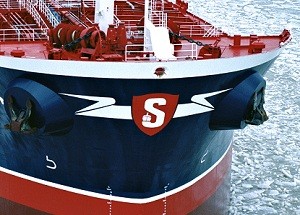Iranian Ship Linked to Houthi Attacks Heads Home Amid Tensions
(Bloomberg) — An Iranian ship that’s been linked to Houthi attacks in the Red Sea is returning home, removing a prominent asset in the area as the Islamic Republic braces...


Photo courtesy Stena Bulk/Conny Wickberg
Given today’s current and forecasted freight markets and fuel prices, Stena Bulk, one of the world’s leading tanker shipping companies, is pushing now more than ever to maximize the relationship between freight and bunker fuel.
To do this, the company is in the midst of an energy management project combining the operation of its vessels at lower, more efficient speeds and the development and adaptation of the latest energy-efficient technology.
“In today’s market, it is very important that we shipowners utilize our existing fleet in the best possible way from an energy and environmental perspective and carefully investigate the potential for improvement, both technological and operational”, says Erik Hånell, President & CEO of Stena Bulk.
The cost of bunker oil accounts today for more than 60% of the freight cost, Stena says, which means that operating vessels as energy efficiently as possible is an obvious, and only, solution. Stena Bulk has determined that in the case of a modern 160,000 dwt Suezmax tanker, the freight rate must average US $40,000 per day over time to justify a speed increase of 0.5 knots compared with the present fuel price level. In other words, Stena says, the freight rate must be doubled before even a small speed increase can be justified based on market conditions so far in 2014.
“In recent years, we have expanded our fleet with the addition of a number of in-house designed Suezmax tankers with the highest environmental class. In our strategic investments, we are focusing on energy efficiency and with the help of our technical development department, we are always on the cutting edge when it comes to safety and the environment. However, existing vessels are also being evaluated in order to save fuel and economise”, Erik Hånell continues.
Adjusting a vessel’s propeller and bulb to its actual speed can make a big difference when it comes to reducing fuel consumption as well, according to Stena. Adding stern tubes and fins are other types of solutions that can have a positive impact on a vessel’s performance.
“The vessels’ technical design is a key factor, but how vessels are operated in terms of energy management is just as important. When it comes to the design and operational excellence of its latest vessels, Stena Bulk has been successful in both these areas”, added Erik Hånell.
Energy Management Project
As a result of efficiency-enhancing measures and reduced speed, Stena Bulk’s fleet has saved more than SEK 65 million, or approximately US $9.1 million, during the last 12 months. Traditional energy efficiency and reduced bunker fuel consumption have been combined with increased efficiency from a more commercial and operational perspective, Stena says.
Stena say’s that the higher efficiency is mainly due to the vessels spending more of their time sailing at an optimum speed, defined as being the most efficient speed for each individual vessel and voyage during the current fuel and freight market condition. This has been achieved primarily by means of an energy budget for each vessel and voyage, which in turn has made it possible to monitor performance more efficiently and in greater detail together with ship optimization and increased awareness on board.
Join the gCaptain Club for curated content, insider opinions, and vibrant community discussions.


Join the 105,983 members that receive our newsletter.
Have a news tip? Let us know.
Access exclusive insights, engage in vibrant discussions, and gain perspectives from our CEO.
Sign Up




Maritime and offshore news trusted by our 105,983 members delivered daily straight to your inbox.



Essential news coupled with the finest maritime content sourced from across the globe.
Sign Up